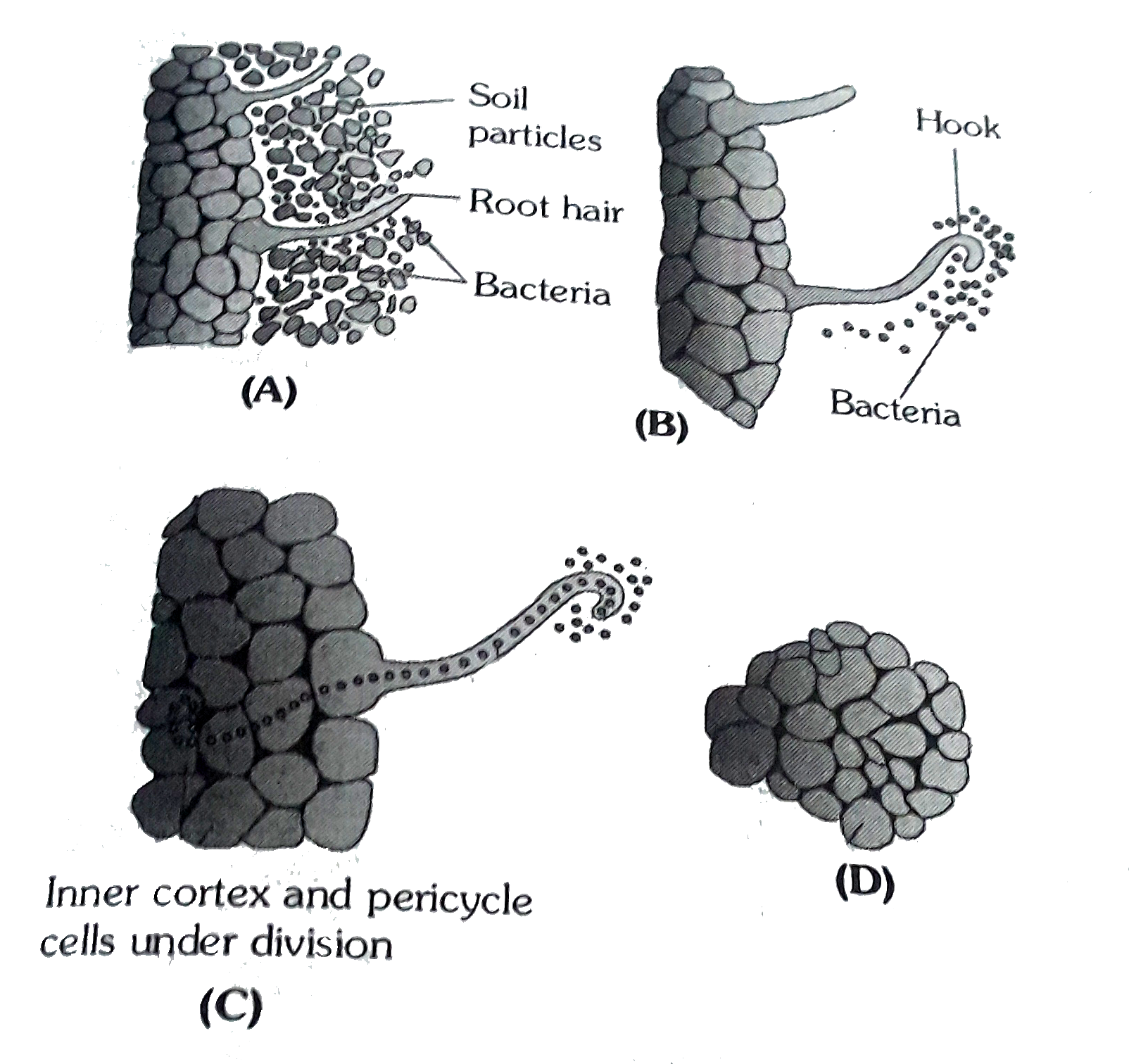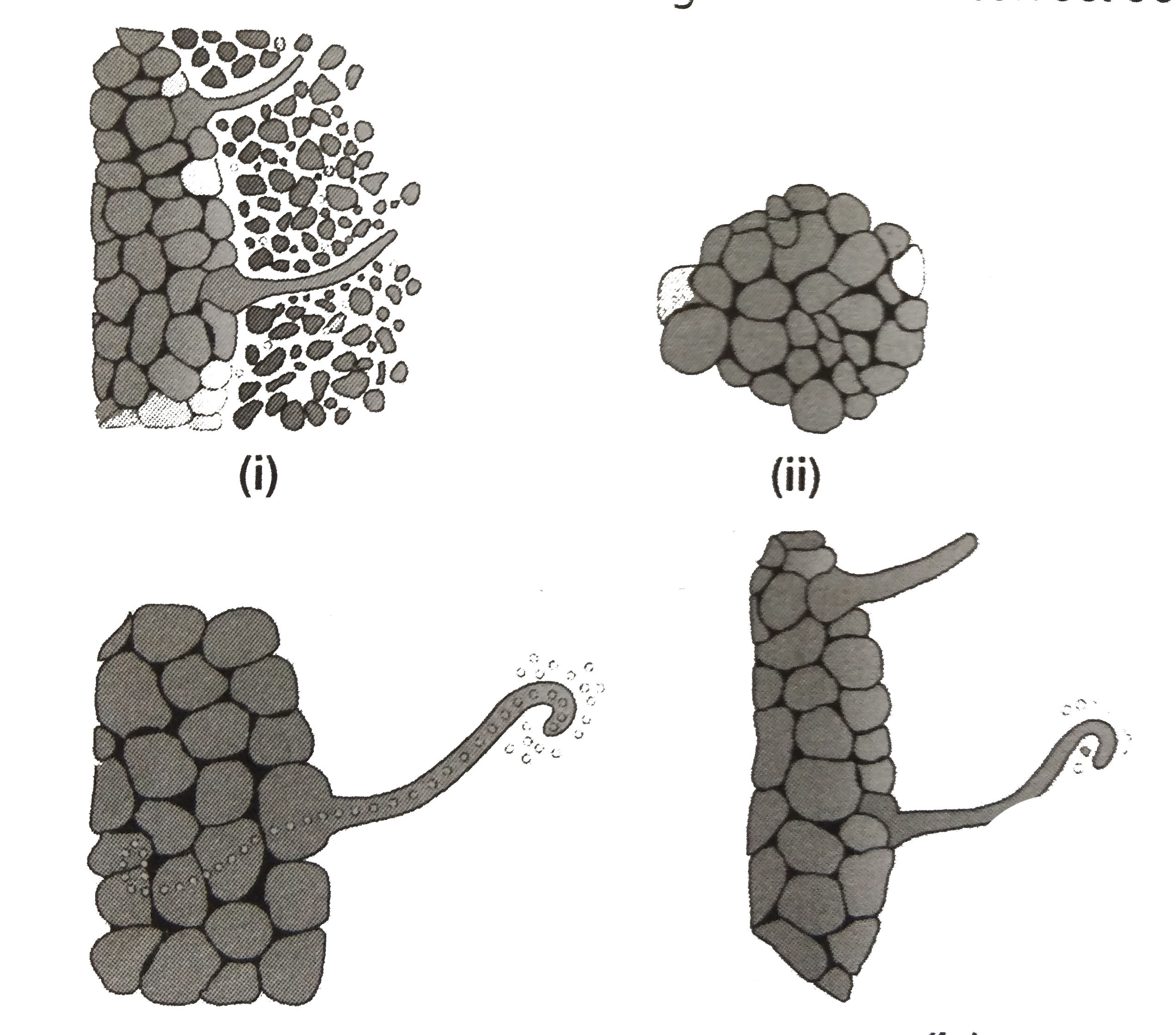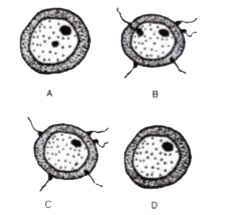Study the given figure which shows the development of root nodules in soyabean. Match the correct explanation and find the correct sequence for labelled diagrams.

(I) Rhizobium bacteria contacting a susceptible root hair.
(II) A mature nodule having vascular connection with roots.
(III). Infection thread carrying bacteria to the inner cortex.
(IV). Curling of root hair due to successful infection.
The correct Answer is:A−I→B−IV→C−III→D−II
Step by step video & image solution for Study the given figure which shows the development of root nodules in soyabean. Match the correct explanation and find the correct sequence for labelled diagrams. (I) Rhizobium bacteria contacting a susceptible root hair. (II) A mature nodule having vascular connection with roots. (III). Infection thread carrying bacteria to the inner cortex. (IV). Curling of root hair due to successful infection. by Biology experts to help you in doubts & scoring excellent marks in Class 12 exams.
Updated on:21/07/2023Topper's Solved these Questions
- MINERAL NUTRITION IN PLANTSBOOK - ALLENCHAPTER - MINERAL NUTRITION IN PLANTSEXERCISE - Match the column
4 Videos
- MINERAL NUTRITION IN PLANTSBOOK - ALLENCHAPTER - MINERAL NUTRITION IN PLANTSEXERCISE - True False
2 Videos
- MICROBES IN HUMAN WELFEREBOOK - ALLENCHAPTER - MICROBES IN HUMAN WELFEREEXERCISE - Question
36 Videos
- MOLECULAR BASIS OF INHERITANCE BOOK - ALLENCHAPTER - MOLECULAR BASIS OF INHERITANCE EXERCISE - Question
66 Videos
Similar Questions

Study the given figures carefully showing the development of root nodules and arrange them in a correct sequence.
View SolutionSelect the incorrect statement from the following.
(a) Rhizobium multiply and colonises the surroundings of roots and gets attached to epidermal and root hair cell.
(b) Successful infection of the root hair causes it to curl .
(c) The nodule establishes a direct Vascular connection with the host .
(d) Infection thread carries the bacteria to xylem and phloem .
View Solution
Knowledge Check
Consider the following steps involved in nodule formation in the root of a legume.
(i). Bacteria release chemicals and enzymes.
(ii). Bacteria stop dividing and form bacteroides.
(iii). Roots secrete chemical atractants.
(iv). Formation of infection thread.
(v). Formation of nodules.
(v). Formation of nodulues.
(vi). Division of infected cortical cells.
(vii) Curlinig of root hair and degradation of their cell wall.
(viii). Infection thread grows along with multiplication of bacteria.
Arrange the steps in the right sequence and mark the correct optionA(iii).(i),(vii),(iv),(viii),(vi),(v),(ii)B(iii),(iv),(viii),(i),(vi),(vii),(ii),(v)C(i),(iv),(iii),(vi),(v),(vii),(viii),(ii)D(i),(iii),(vi),(iv),(viii),(ii),(v),(vii)Study the following step which are followed during the process of gene therapy while treating a patient of SCID
(i) Retrovirus infects lymphocytes extracted from bone marrow of the patient and cultured
(ii) Engineered cells are injected into patient's bone marrow
(iii) Normal allele is inserted into a retrovirus
(iv) Retrovirus makes a DNA copy of its RNA. This DNA carrying the normal allele gets inserted into the chromosome of the host cell
Arrangement the above given steps in correct sequence and select the correct optionA(iii),(i),(ii),(iv)B(iii),(i),(iv),(ii)C(iv),(ii),(iii),(i)D(iv),(iii),(i),(ii)
Given below are diagrams showing the different stages in the process of fertilisation of an egg in the human female reproductive tract.
Study the diagrams and answer the questions

(i) Arrange the letters given below each diagram in a logical sequence to show the correct order in the process of fertilisation.
(ii) Where does fertilisation normally take place? What is 'Implantation' that follows fertilisation ?
(iii) Mention the chromosome number of the egg and zygote in humans.
(iv) Explain the term 'Gestation'. How long does Gestation last in humans ?
(v) Draw a neat, labelled diagram of a mature human sperm.
View SolutionDuring nodule formation in leguminous plants, an infection thread is produced carrying the __(i)__ into the __(ii)__ of the root, where they initiate the nodule formation in the __(iii)__ of the root. Fill up the blanks by choosing the correct option.
View SolutionGo through the following matches with reference to the elements and their deficiency symptoms in plants:
(i) Sulphur - Reduced nodulation in legumes
(ii) Boron - Whiptail disease
(iii) Sulphur - Blossom end root of tomato
(iv) Nitrogen - Wrinkling of cereal grains
Which of these are correct
View SolutionWhich one of the followings plants is monoecious?
View SolutionConsider the following statements
I. sulphur is present in two amino acids cysteine and valine
II. Lower level of N,K,S and Mo causes inhibition of cell division.
III. Microbe that fix nitrogen in the roots of non-leguminous plants alums in frankia
IV. Denitrification is carried by bacteria Nitrosomonas and nitrobacter
Select the correct pair of statements.
View SolutionStatement - I: Beijernickia is free living nitrogen fixing bacterium.
Statement - II: The enzyme, nitrogenase which is capable of nitrogen reduction is present exclusively in prokaryotes.
Statement- III: The root nodules formed in soyabean never establishes a direct vascular connection with the host for exchange of nutrients.
Select the suitable option wr.t. statements I to III.
View Solution
